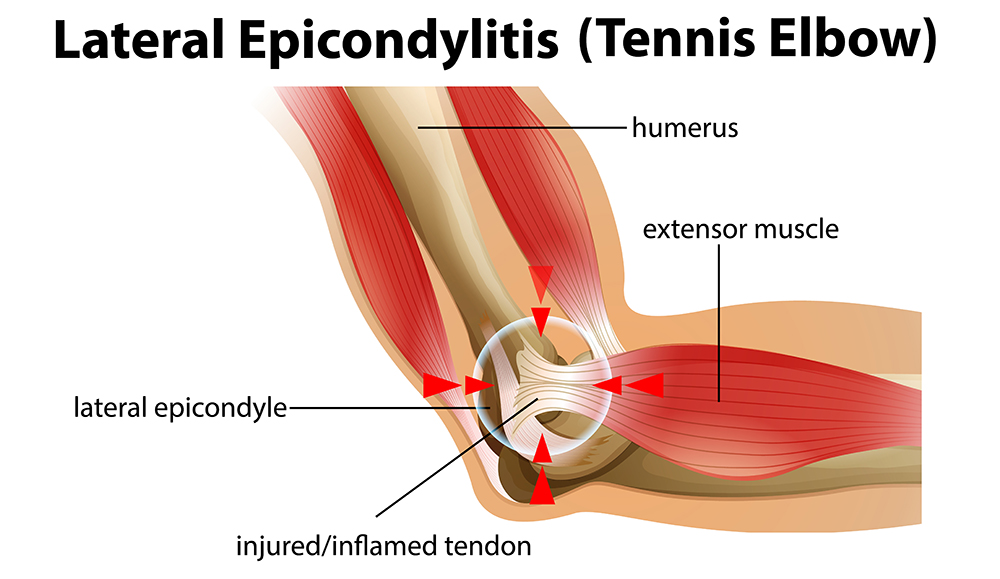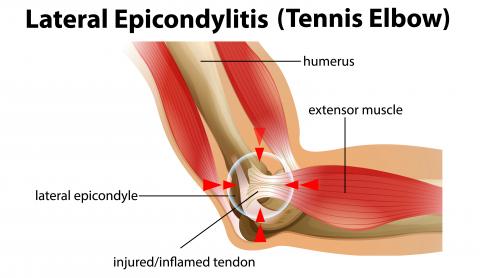Pain in the elbow can be mild or it can be quite severe and debilitating. If it is severe it can have an effect on your everyday lifestyle and activities, particularly if it is in your dominant arm.
The most common causes of elbow pain are:
- Tennis elbow or lateral epicondylitis (tendonitis)
- Golfers elbow or medial epicondylitis (tendonitis)
- Bony fractures
- Bursitis
- Nerve entrapment
- Arthritis
 The most common type of elbow pain is lateral epicondylitis or otherwise known as 'tennis elbow'.
The most common type of elbow pain is lateral epicondylitis or otherwise known as 'tennis elbow'.
Medial epicondylitis or Golfer's elbow' is a less common injury, but also seen quite regularly in clinical practice. As the name infers, you don't have to play tennis or golf to get these injuries they can occur as a result of a range of physical activities – racquet sports, cricket and batting sports, rowing, canoeing, weightlifting, hockey, wrestling, swimming , and also as a result of repetitive work tasks with certain occupations or hobbies, like gardening, typing and musical instruments among many other activities.
Overuse or repeated pressure on the tendons near the elbow joint can overload these tissues and tendons. If overload occurs, it can cause pain around the elbow, particularly when using the wrist and hand. Depending on the location and severity of the injury, full recovery can take from weeks to months and in some cases longer especially if the load continues.
The elbow is formed by 3 bones, the distal humerus, the radius and the ulna; these form the medial and lateral epicondyles of the elbow. Injury to the tendons that anchor muscles to the epicondyles on either side of the elbow are a common cause of elbow pain, as stated above, this is when tennis or golfers elbow occurs.
The lateral epicondyle– the outer side of the elbow. The muscles of your forearm responsible for the action of curling your wrist backwards, are anchored to this bony point. Pain at this point is called lateral epicondylitis (also known as 'tennis elbow'), and also indicates that the tendon is inflamed. This area is particularly susceptible to strain because it has a poor blood supply.
The medial epicondyle– the inner side of the elbow. The muscles of your forearm responsible for curling your wrist up, are anchored to this bony point. Pain at this point is called medial epicondylitis (also known as 'golfer's elbow'), and also indicates that the tendon is inflamed.
Causes of elbow pain:
Some of the many circumstances that may contribute to elbow injuries include:
- lack of strength or flexibility in the forearm muscles
- lack of strength in the shoulder muscles
- instability of the elbow joint
- poor technique during sporting activities that overstrains the elbow joint
- inappropriate sporting equipment
- repetitive movements of the hands and arms
- continuously making the muscles and joint take heavy loads
- neck symptoms or nerve irritation.
- Inflammatory conditions of the body
While overuse injuries like tennis and golfer's elbow are the most common causes of elbow pain, other conditions can also include:
- radiohumeral bursitis – bursitis is inflammation of a bursa. Bursae are small sacs that contain fluid to lubricate moving parts such as joints, muscles and tendons. Bursitis may be caused by repetitive use or frequent pressure or by injury to the elbow
- osteoarthritis – degenerative joint changes within the elbow
- referred pain – injury to the neck can irritate the nerves that feed the arm and cause referred pain around the elbow joint
- nerve entrapment – if the radial nerve in the arm becomes impinged, it can cause pain at the elbow
- ligament sprain – connective tissue called ligaments help to support the elbow, if they are injured then it can result in pain at the elbow
- bone fracture – a heavy blow or fall onto the elbow can cause the bone to fracture
- avulsion fracture – this is when a strong muscle breaks off a small piece of bone causing elbow pain
- osteochondritis dissecans – loose cartilage or bone in the joint
How to treat elbow pain?
Some elbow pain can be treated at home with rest and pain relief, however if symptoms continue, or if the elbow pain is reoccurring, see your doctor or osteopath. Treatment options may include:
- exercises prescribed by your osteopath to gradually strengthen the tendons
- soft tissue massage and manual tissue techniques
- ice
- Rest/ avoid repetitive elbow usage that caused the initial problem
- acupuncture
- taping or bracing your elbow
- anti-inflammatory and pain-relieving medication can be useful, however does not necessarily improve the long term results
- surgery – in severe, long term cases, this may be an option
- there is now evidence that corticosteroid injections has longer term side effect, as a result these are no longer recommended in the majority of cases.
How can I prevent elbow pain and reduce the risk of injury occurring?
- Remember to stretch thoroughly after playing sport
- Use ergonomic and fit for purpose equipment when playing sports and doing hobbies
- Use good technique when playing sports
- If there is a known weakness, your osteopath can help strengthen weaker muscles
- Modify repetitive tasks at work and at home
- If there is a known weakness using an elbow support can help prevent further injury when using the forearms and wrists
- Regular osteopathic treatment can help strengthen the arm and prevent further injury occurring
Image by brgfx on Freepik

